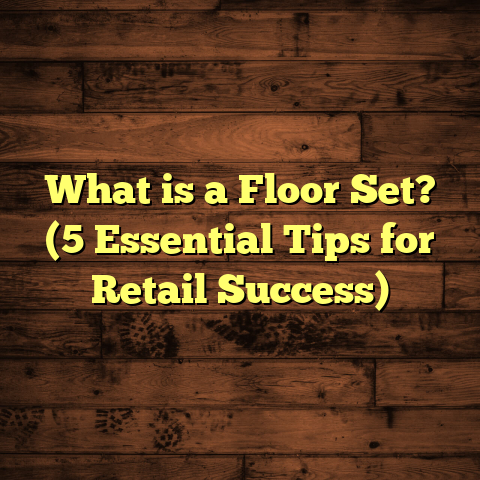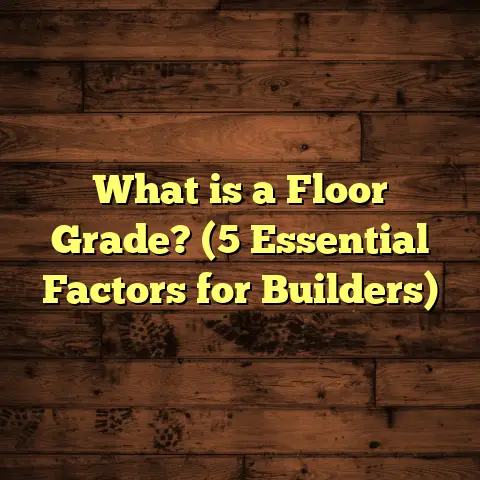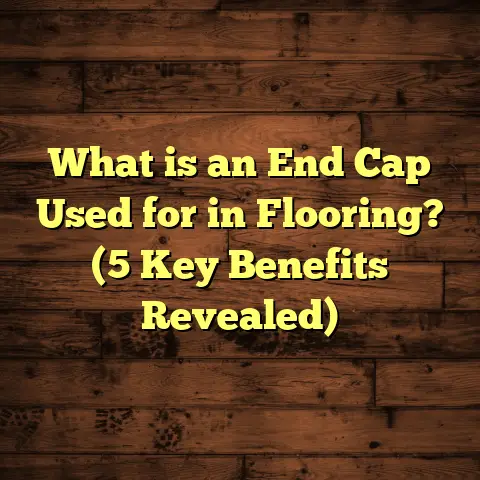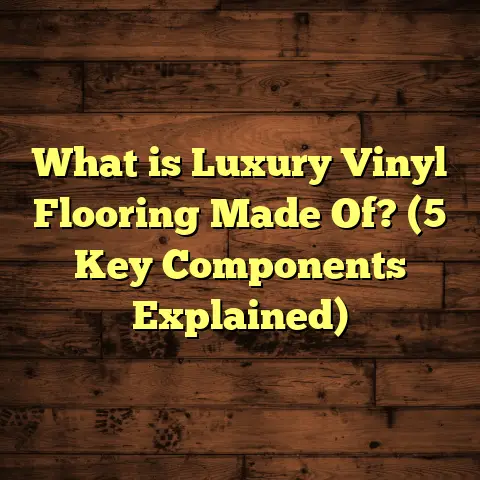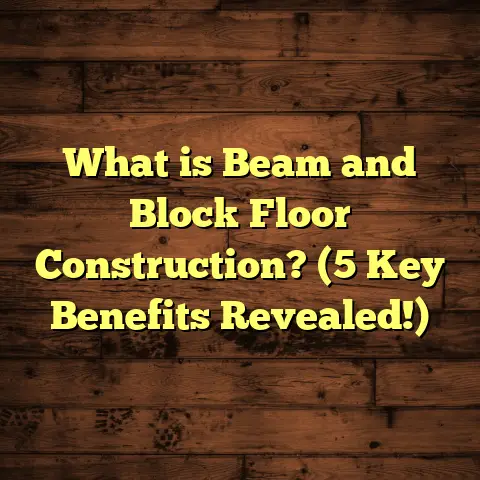What is a Gym Floor Made Of? (5 Materials You Didn’t Know About!)
Imagine you walk into a gym for a big game or just to get your workout going. You hear the bounce of basketballs, the thud of heavy weights hitting the floor, and the shuffle of sneakers moving fast. But have you ever paused to think about what exactly is beneath your feet? What is a gym floor made of?
You might assume it’s just wood or rubber, but gym flooring materials can be surprisingly varied and complex. Over the years, I’ve installed and inspected hundreds of gym floors—from high school courts to professional training centers—and I’ve learned that the right flooring is critical for athlete safety, performance, and longevity of the facility. Plus, there are some materials used in gym floors that might surprise you!
Let me take you through five materials commonly found in gym floors that you probably didn’t know about. I’ll share my own experiences, detailed measurements, cost insights, and even how I use modern tools like FloorTally to keep my projects on budget and on time.
What Is a Gym Floor Made Of?
When we say “gym floor,” we often think of the surface athletes run and jump on. But in reality, a gym floor is typically a multi-layered system designed for durability, shock absorption, traction, and safety.
The top surface is just one part. Beneath it is a subfloor or underlayment system that helps absorb impact and stabilize the floor. This multi-layer approach protects athletes’ joints and reduces injury risks. It also ensures the floor won’t warp or crack under heavy use.
Different gyms have different needs. A basketball court demands a surface with a bit of “give” for jumping but firm enough for quick pivots. A weightlifting section needs impact resistance against heavy dropped weights. Multipurpose gyms need materials that can handle everything from aerobics to roller skating.
I’ve seen gym floors made of materials ranging from traditional hardwood to rubber, vinyl, cork, and even specialty finishes like polyurethane coatings. Each material has properties that make it uniquely suited for certain sports or fitness activities.
1. Maple Hardwood – The Timeless Classic
If you ask anyone about gym floors, hardwood—especially maple—is usually the first material that comes to mind. It’s been the go-to choice for decades in basketball courts worldwide.
Why Maple Hardwood?
Maple stands out for several key reasons:
- Durability: Maple is one of the hardest domestic woods in North America. It rates roughly 1450 on the Janka hardness scale, meaning it resists dents and scratches better than most other species.
- Shock Absorption: It offers slight natural flex under pressure, which helps absorb impact forces when athletes jump or land.
- Appearance: Its light color and fine grain give gym floors that classic bright look.
- Consistency: Maple grows straight and dense, making it ideal for long planks without knots that could weaken the floor.
Installation Details
Installing a maple gym floor isn’t as simple as laying down wood planks. It typically involves:
- Subfloor preparation: This includes leveling concrete or wooden surfaces to within 1/8 inch tolerance across the entire gym.
- Vapor barrier installation: To prevent moisture from rising from below.
- Sprung subfloor system: Many gyms incorporate an engineered wood subfloor with rubber pads or foam underneath to create a “springy” feel. This system reduces fatigue and injury risk.
- Hardwood installation: Maple strips are usually 2 1/4 inches wide by 3/4 inch thick.
- Sanding and finishing: After installation, the floor is sanded smooth and coated with multiple layers of polyurethane finish for protection.
Costs and Timeframes
From my own projects, here’s what to expect cost-wise:
- Materials: Premium maple hardwood costs around $8 to $12 per square foot.
- Installation: Labor adds another $7 to $10 per square foot depending on complexity.
- Finishing: Polyurethane coatings range from $1.50 to $3 per square foot per coat.
- Total: For a standard 5,000 sq ft high school gym court, expect $80,000 to $100,000 all-in.
- Time: Installation typically takes 2-3 weeks from subfloor prep to finish curing.
Personal Experience
One project in Ohio stands out. The school wanted a court that looked great but could withstand daily PE classes plus varsity games. We installed a multi-layer sprung subfloor with 3/4 inch maple planks and finished with four coats of water-based polyurethane. The floor still looks fantastic three years later with no major repairs.
2. Rubber Flooring – The Heavy-Duty Cushion
Rubber flooring often gets overlooked when people think of gym floors, but it’s actually a staple in many fitness areas—especially where weights are involved.
Why Rubber?
Rubber’s properties make it ideal for impact zones:
- Shock absorption: Rubber reduces impact forces dramatically—essential for weight rooms.
- Durability: It can withstand dropped dumbbells and barbells without cracking.
- Safety: Its non-slip surface prevents accidents during sweaty workouts.
- Noise reduction: Rubber muffles sounds better than hardwood or concrete.
Types of Rubber Flooring
Rubber gym flooring usually comes in two forms:
- Rubber tiles: Interlocking squares roughly 24×24 inches in size.
- Rolled rubber sheets: Available in thicknesses from 1/8 inch up to 3/4 inch.
Thickness impacts comfort and protection; weight rooms often use 3/8 inch or thicker rubber.
Costs and Installation
From my experience installing rubber flooring in Denver gyms:
- Material costs: $2.50 to $5 per square foot depending on thickness and quality.
- Installation labor: Around $2 per square foot.
- Total cost: About $4.50 to $7 per square foot all-in.
- Installation time: Typically 1-3 days for an average room (2,000 sq ft).
Unique Insights
I worked on a CrossFit gym where we installed recycled rubber flooring made from ground-up tires. It was an eco-friendly choice that also saved them about 20% compared to virgin rubber flooring.
Rubber flooring requires minimal maintenance—regular sweeping and occasional mopping keep it looking good for years.
3. Vinyl Sports Flooring – The Flexible Contender
Vinyl sports flooring has gained popularity in multipurpose gyms because it offers versatility and affordability.
What Makes Vinyl Popular?
Vinyl is common because:
- Cost-effectiveness: It can be much cheaper than hardwood or rubber.
- Variety: Comes in many colors and patterns so gyms can customize branding or court lines.
- Moisture resistance: Unlike wood, vinyl resists water damage.
- Easy installation: Usually rolls out quickly or comes in interlocking tiles.
Specifications
Typical vinyl sports flooring thickness ranges from 6mm to 8mm (about 1/4 inch to 5/16 inch).
The surface texture offers enough grip for most indoor sports without being slippery.
Cost Breakdown
In one project I managed for a community center in Florida:
- Vinyl rolls cost about $3 per square foot.
- Installation ran around $2 per square foot.
- Total costs: Approximately $5 per square foot.
- Installation time: A few days for a 4,000 sq ft gym.
Maintenance
Vinyl requires little maintenance beyond regular cleaning with mild detergents. It doesn’t need sanding or refinishing like wood does.
4. Cork Flooring – The Soft Surprise
Cork isn’t widely known as a gym floor material but it has some surprising benefits that make it ideal for certain areas like yoga rooms or stretching zones.
Advantages of Cork
- Shock absorption: Cork compresses underfoot but rebounds quickly—great for joint relief.
- Natural insulation: Keeps floors warmer than wood or concrete.
- Hypoallergenic: Resistant to mold and dust mites.
- Eco-friendly: Cork is harvested sustainably from tree bark without harming trees.
Installation Notes
Cork panels typically measure around 12×36 inches and come in thicknesses from 1/4 inch up to 3/8 inch.
They are glued down over smooth subfloors and sealed with special finishes for durability.
Cost Considerations
Cork flooring costs between $5 to $10 per square foot depending on thickness and quality.
Installation labor can add another $2-$4 per square foot due to the careful gluing and sealing process.
Real-Life Example
I helped install cork flooring in a yoga studio within a gym in Portland. Clients loved how soft yet supportive it felt underfoot compared to hardwood or vinyl. It also helped reduce noise levels during quiet classes.
The main downside? Cork can dent under heavy equipment so it’s best reserved for low-impact zones.
5. Polyurethane Coatings – The Unsung Hero
Polyurethane coatings aren’t a flooring material you walk on by itself but rather the protective finish applied over hardwood gym floors.
Why Polyurethane?
Gym floors endure constant wear—from sneakers dragging to weight drops—so protective coatings are essential:
- Durability: Polyurethane provides a tough barrier against scratches, moisture, and stains.
- Slip resistance: Special formulas add traction without stickiness.
- Appearance: Enhances wood grain while adding gloss or matte finishes.
- Longevity: Extends floor life by years when reapplied every few years.
Types of Polyurethane
- Oil-based polyurethane: Very durable but has strong odors during application.
- Water-based polyurethane: Less odor, quicker drying times but slightly less durable.
- UV-cured polyurethane: Used in professional gym floors for fast curing and excellent protection.
Costs & Maintenance
Re-coating costs run between $1.50 and $3 per square foot depending on floor size and condition.
I advise gym managers to plan recoating every 3 to 5 years to avoid costly repairs down the line.
How I Use FloorTally for Budgeting My Flooring Projects
Keeping track of costs across different materials is one of the toughest parts of my work as a flooring contractor. That’s where FloorTally has been invaluable.
This tool lets me input local prices for labor and materials, calculate waste factors (because nobody wants to run short mid-job), and compare options side-by-side quickly. It saves me from hours of manual math.
For example, when pricing out a recent project for a multipurpose gym with vinyl flooring plus rubber weight zones, FloorTally helped me create detailed line-item estimates showing total costs including installation, finishes, and prep work.
It also helped justify choices to clients by providing clear visualizations of how costs break down—something I’ve found makes approvals much smoother.
More Thoughts on Choosing Gym Floor Materials
When discussing gym floors with clients or colleagues, I often get asked: “Which material is best?” Honestly, it depends on many factors:
- What activities will happen in the space?
- How much traffic will the floor see daily?
- What’s the budget?
- How important is maintenance ease?
- Are there environmental concerns?
For example, if you’re outfitting a basketball court primarily used for games, maple hardwood with polyurethane finish is unbeatable for performance and appearance but comes at a higher cost and maintenance level.
If you’re setting up a functional fitness box with heavy weights being dropped constantly, rubber flooring is safer and more durable but lacks the aesthetic appeal of wood.
Multipurpose gyms benefit from vinyl’s flexibility—affordable, easy to clean, and customizable though less cushioned than other options.
And don’t overlook specialized areas like yoga studios where cork flooring can provide comfort few other materials match.
Some Interesting Data Points From My Experience
To give you some perspective based on my past projects:
| Material | Typical Thickness | Cost Range ($/sq ft) | Installation Time | Lifespan (Years) | Maintenance Notes |
|---|---|---|---|---|---|
| Maple Hardwood | 3/4 inch | 15 – 20 | 2 – 3 weeks | 20+ | Requires periodic recoating every ~5 yrs |
| Rubber Flooring | 3/8 – 1/2 inch | 4 – 7 | 1 – 3 days | 10+ | Minimal cleaning; occasional deep clean |
| Vinyl Flooring | 6 – 8 mm | 4 – 6 | Few days | 10 – 15 | Easy cleaning; no refinishing needed |
| Cork Flooring | 1/4 – 3/8 inch | 7 – 12 | Few days | 10 | Requires resealing every few years |
| Polyurethane Coating | N/A | 1.5 – 3 (per coat) | Few days | N/A | Recoat every 3 -5 years recommended |
Final Thoughts From My Workbench
Gym floors are more than just surfaces; they’re carefully engineered systems combining multiple materials chosen for specific benefits—from shock absorption to durability to aesthetics.
Over years working in this field, I’ve learned each material has its place depending on gym use cases:
- Maple hardwood courts remain iconic but require investment in installation and maintenance.
- Rubber flooring saves joints in weightlifting areas while offering longevity at reasonable costs.
- Vinyl provides versatility for spaces needing quick turnarounds between activities.
- Cork brings unexpected comfort in quiet workout zones like yoga rooms.
- Polyurethane coatings protect all these surfaces when applied properly over time.
Thinking about gym flooring? Ask yourself what activities dominate your space and how much traffic you expect. Then weigh your budget against desired performance features—and consider mixing materials if your facility has varied needs.
If you’d like help estimating costs or planning your project, tools like FloorTally can make budgeting straightforward by consolidating labor and material prices into easy-to-understand reports tailored to your location.
And if you want advice based on real-world experience with installation challenges, material longevity, or maintenance tips—just ask! I’m always happy to share what I’ve learned from years on job sites nationwide.
Have you ever noticed what kind of floor your local gym uses? Or maybe you’ve worked with some unusual materials? I’m curious what your experience has been like!
